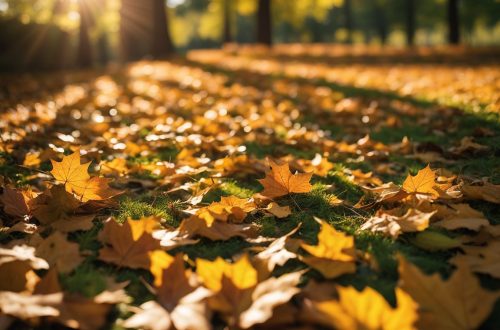
Best Time to Plant Grass Seed in Ohio: Green Up!
The best time to plant grass seed in Ohio is typically in the fall, from mid-August to October. Early spring, from March to April, is also suitable for seeding.
Embarking on a lawn improvement journey in Ohio requires understanding the optimal seeding times to ensure robust grass growth. Fall presents the ideal window for planting grass seed in the Buckeye State, harnessing the advantage of cooler temperatures and reduced weed competition, which facilitate seed germination and root development.
This timing also benefits from autumn rains, which provide natural irrigation. For those who miss the fall period, early spring offers a secondary opportunity, taking advantage of the season’s moderate temperatures before the onset of summer heat. Proper timing aligns with nature’s cycles, setting the stage for a lush, green lawn that can thrive in Ohio’s climate. Choosing the right moment to plant is a pivotal step in cultivating a resilient and healthy turf that can withstand the varying conditions of the Midwest.
Ohio’s Grass Growing Cycle
Ohio’s diverse climate zones significantly influence grass seed planting. The state’s northern region experiences cooler temperatures, while the southern areas are warmer. These variations necessitate choosing the right grass type for successful growth.
Considering Ohio’s climate zones, cool-season grasses like Kentucky Bluegrass, Perennial Ryegrass, and Fine Fescue thrive well. These species are resilient to cold winters and moderate summers, making them ideal for Ohio lawns.
| Climate Zone | Grass Type |
|---|---|
| Northern Ohio | Kentucky Bluegrass, Perennial Ryegrass |
| Central Ohio | Fine Fescue, Kentucky Bluegrass |
| Southern Ohio | Tall Fescue, Kentucky Bluegrass |
Planting grass seed in the right season ensures strong root development. Spring and early fall provide optimal growth conditions for grass seeds in Ohio. It allows the grass to establish before the onset of extreme weather.

Credit: www.naturesseed.com
Spring Planting Pros And Cons
Planting grass seed in Ohio during spring has its advantages and disadvantages. A key upside is the opportunity for early growth, allowing the grass to establish itself before the heat of summer. This early start gives grass a better chance to develop a robust root system, leading to a lusher lawn.
Yet, there’s a significant downside: the risk of frost damage. Ohio’s spring can be unpredictable, with chilly temperatures potentially returning even after a warm spell. Young seedlings are vulnerable to frost, which can halt growth and damage new grass.
Summer Sowing Challenges
Planting grass seed during Ohio’s summer can be tricky. High temperatures cause significant heat stress on new seedlings. Young grass struggles to establish in the intense heat. Consistent watering is crucial to prevent the seed from drying out.
Weeds are another obstacle for seedlings in summer. They thrive in warm weather and often outcompete new grass. Effective weed control is essential. This ensures your grass seedlings have a fighting chance. Choose a time for planting when weed growth is slower.

Credit: www.youtube.com
Autumn Advantages
Planting grass seed in Ohio thrives best during autumn. This season offers optimal soil temperatures, which are crucial for seed germination. Typically, the soil should be warm enough to encourage growth but cool enough to prevent overheating.
Additionally, autumn brings with it a significant benefit: reduced weed pressure. Weeds compete with grass for resources, but they grow less actively in fall. This allows new grass to establish without heavy competition, leading to healthier lawns with thicker growth.
Winter Dormant Seeding
Dormant seeding is planting grass seed during winter. Seeds lie dormant until spring. Success relies on proper timing and seed-to-soil contact. Ohio’s cold winters make dormant seeding viable.
Seeds must be sown before the ground freezes. This allows for natural stratification. It’s essential to use the right grass mix for Ohio’s climate. Perennial ryegrass and fescues are often recommended.
For cold weather planting, it’s crucial to monitor temperature forecasts. Seeds shouldn’t be planted during unseasonable warmth. Protecting the seeds from erosion is also key. Mulching helps shield seeds from harsh conditions.
Preparation Steps For Seeding
Proper soil preparation is crucial before planting grass seed. Begin by conducting a soil test to determine nutrient levels and pH balance. This information guides the amendment process, ensuring optimal soil conditions for germination.
Choosing the right seed is equally important. Look for high-quality grass seed suitable for Ohio’s climate. Select a blend that matches your lawn’s sun exposure, whether full sun, shade, or a mix. Quality seeds lead to stronger, healthier lawns.
Seeding Techniques For Success
Choosing the right seeding technique is crucial for lush lawns. Broadcast seeding is scattering seeds directly onto the soil surface. It’s quick and cost-effective. Yet, it might lead to uneven growth. Drill seeding, on the other hand, places seeds at a uniform depth. This method ensures consistent seed germination and a more uniform lawn.
For optimal growth, seeds must touch the soil. This contact is key for the seeds to get water, nutrients, and light. Without it, seeds may not sprout. To improve contact, use a roller or rake after broadcasting. For drilled seeds, the equipment ensures the right contact. Remember, good contact equals better chances for sprouting.
Post-planting Care
Patchy growth can be frustrating for Ohio gardeners. Proper soil preparation is essential. Test the soil to ensure it has balanced nutrients and proper pH levels. Seed during the optimal planting window for better establishment. Use high-quality seed that’s suitable for Ohio’s climate. Over-seeding may be necessary to achieve uniform growth.
Preventing pests and diseases starts with healthy lawn practices. Choose disease-resistant grass varieties and apply appropriate fertilizers sparingly. Regular mowing to the right height helps prevent issues. Ensure adequate water drainage to avoid standing water which attracts pests. Should problems arise, use targeted treatments recommended for Ohio lawns.
Troubleshooting Common Issues
Proper mowing strategies are essential for healthy grass growth. Regular trimming, at the right height, prevents stress on your lawn. It’s crucial to keep mower blades sharp for clean cuts. During peak growing seasons, cut the grass weekly.
Seasonal lawn health requires attention to timing. Spring and fall offer optimal conditions for grass seed germination. Use a slow-release fertilizer to nourish new growth. Aerate the soil annually for better water and nutrient absorption.
| Season | Lawn Care Activity |
|---|---|
| Spring | Start mowing, apply fertilizer, aerate |
| Summer | Maintain mowing, manage weeds |
| Fall | Prepare for seeding, fertilize, aerate |
| Winter | Minimize traffic on dormant grass |

Credit: www.lawndoctor.com
Frequently Asked Questions
When Should I Reseed My Lawn In Spring Ohio?
Reseed your lawn in Ohio’s spring when soil temperatures consistently reach 50-65°F, typically from mid-April to early June.
What Month Should I Put Grass Seed Down?
The best time to plant grass seed is during the fall or spring months.
What’s The Best Grass Seed For Ohio?
The best grass seed for Ohio typically includes a mix of Kentucky Bluegrass, Perennial Ryegrass, and Fine Fescue due to the state’s climate.
Is It Better To Plant Grass Seed In Spring Or Fall?
Planting grass seed in fall is typically better, as cooler temperatures and more moisture help seedlings establish. Spring seeding is also an option but requires more watering and weed management.
Conclusion
Timing is crucial for seeding grass in Ohio. Aim for late summer to early fall, ensuring roots establish before winter. Spring is your second-best option, avoiding the summer heat. For a lush lawn, choose the right moment and give your grass the best start.
Happy planting!



